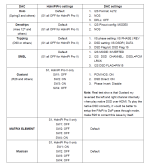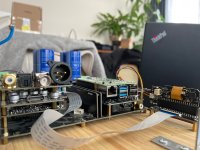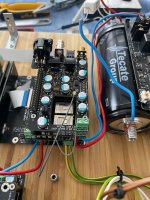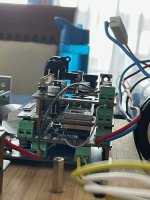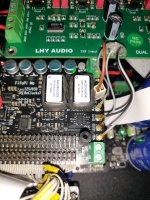I don't think 3.3V is taken from GPIO by HDMI Transmitter if you have installed a power connector at J3. To install J3, you need to remove L1. By removing L1, the HDMI Transmitter no longer takes power from the GPIO.Thank you very much for your help! It is working now. It seems to be importand to apply the 3.3V to both, the Isolator AND the HDMI Transmitter. I'm still wondering why, because 3.3V is actually shared via GPIO. Anyway, it is working nice now, thank you again!
FifoPiMa has a 3.3V LDO when share the RPi 5V. The XO sockets are in 3.3V voltage.I have a question on SC PURE clocks if someone could help with.
I'm thinking of building a simple stack of RPi4 >> FifoPiMa >> TransportPi. I'm thinking of shorting 1-2 and 3-4 of FifoPiMa to share the 5V power supply with RPi4 and TransportPi. And I want to replace the clocks on FifoPi Ma with SC Pure. The SC Pure manual says it needs a 3.3V clean power. Will it be a problem if I share the 5V power with RPi4 and introduce noise? CC: @iancanada
Ian
The best way using the LinearPi is keeping the AC input always connected. and using the control chain cables to control the on/off of multiple LinearPis. You can make one LinearPi as master and others as salve.Hi all. I'm posting here to seek some help with two of my Ian Canada builds. I've built one stack for myself and one for a friend of mine. Currently experiencing 2 somewhat different issues.
I've attached 2 pics of the build, but I'm using 3 toroidal tansformers from toroidy (all with 2 secondaries, one sec for each linearpi) 9V 60VAC, linear pi with ucconditioner (2 of them in series to power the opa861), station pi, fifo pi q7.
- from fifopi is connected to station pi gnd and from there to the chassis on the star connection. All transformers gnd is connected to the same star point and IEC the same. I've attached a pic for visual.
1. My problem:
Whenever I plug in the stack to the wall outlet, the DC6 output leds are flashing on the linear supplies. On all 5. Not a biggie, but wanted to see if there's a way to avoid that or if it's normal. There's no power on switch other than the one controlling the on/off on the linear pi.
I have tried simulating an on/off switch by using an extension socket that has one. Same result. Maybe a slow start would help? Or something else?
2. My friend's problem, big problem:
First, an important note --> his ac wall outlet does not have an earth grounding. More precisely his entire apartment does not have grounding
With the stack powered off, but plugged in to the outlet (so only the input leds on the linear supplies are on), when he unplugs the XLR cables from one amplifier and then plugs them to a different amplifier (or maybe the same) the output DC6 leds on the linear supplies flash. Not always, not with all amplifiers or preamps (or so he says).
Bigger problem is that sometimes they flash and they all turn off. Even the input ones. And then the supplies don't want to turn on at all. Everything is turned off and doesn't want to turn back on again.
Last time after about 2hours they started working.
Before that he brought the build to my place, I plugged it in and it worked flawlessly. I do have earth grounding.
I have basic understanding of these things, not advanced, but enough to build a Ian stack.
Thank you in advance for any help!
Please don't use the AC power for the on/off. It's normal that D6 flashing one time when AC power is applied for initialization.
Ian
Please just install the MonitorPiPro to a RPi along externally to see any display.First I want to thank the people that have been helping me.
I have assembled and have working:
https://iancanada.ca/products/flags...rk-music-streamer-kits?variant=47606889185580
I have working Roon - This device - HDMI cable to Gustard R26.
I have no display on #49B MonitorPi Pro. How do I trouble shoot issue?
Thanks again - Dave
Ian
HdmiPiProII and FifoPiQ7 works perfectly for Gustard R26 at Native DSD. You just need to connect the small cable from Q7 to the HdmiPiPro which can pass the DSDEN signal to Pin15.@sernikus
That’s still won’t work with the R26 for DSD.
Please find the picture for the connections. I just test it the day before yesterday.
 HdmiPiProII_R26_R2R by Ian, on Flickr
HdmiPiProII_R26_R2R by Ian, on FlickrAttachments
@iancanada
In your notes you wrote “
Is that then DOP? Not trying to start an argument about Native not being DoP, (I’m in the camp of if it’s DoP, it’s DoP, and that’s not native) just trying to understand your device features.
DSD with the R26 and that 1bit Dac is pretty atrocious anyway.
In your notes you wrote “
| To play the native DSD correctly, it would be better to setup the FifoPi to DoP pass through mode, make R26 to correct this issue by itself. |
DSD with the R26 and that 1bit Dac is pretty atrocious anyway.
@camrector
With hardware DoP decoder, there will be no difference with native DSD. Why?
DoP is a protocol to transfer native DSD data within the 24bit PCM (I2S) protocol. By using DoP, DSD data can be sent using existing I2S or S/PDIF connections. DoP is a bit perfect protocol and converts back into native DSD with no losses. There are NO differences between the original native DSD stream and one re-generated back into DSD format from a DoP stream. Many of the common software packages used to playback music on RaspberryPi’s or PC are beginning to offer DoP output of DSD data as a means to output DSD via the I2S pins on the expansion header.
Unfortunately RPi doesn't play native DSD over GPIO, DoP only. If you really care about the native DSD format, the only way to take is making RPi output music through USB. In this case, a ReceiverPiDDC or StationPiPor will be required in the system.
HdmiPiProII and FifoPiQ7 combination plays both Native DSD and DoP into the R26 R-2R DAC.
Please let me know if you have any questions.
Ian
With hardware DoP decoder, there will be no difference with native DSD. Why?
DoP is a protocol to transfer native DSD data within the 24bit PCM (I2S) protocol. By using DoP, DSD data can be sent using existing I2S or S/PDIF connections. DoP is a bit perfect protocol and converts back into native DSD with no losses. There are NO differences between the original native DSD stream and one re-generated back into DSD format from a DoP stream. Many of the common software packages used to playback music on RaspberryPi’s or PC are beginning to offer DoP output of DSD data as a means to output DSD via the I2S pins on the expansion header.
Unfortunately RPi doesn't play native DSD over GPIO, DoP only. If you really care about the native DSD format, the only way to take is making RPi output music through USB. In this case, a ReceiverPiDDC or StationPiPor will be required in the system.
HdmiPiProII and FifoPiQ7 combination plays both Native DSD and DoP into the R26 R-2R DAC.
Please let me know if you have any questions.
Ian
yes, I think you are right. By removing L1 on the Transmitter, the GPIO transport of the 3.3V seems to get cut.I don't think 3.3V is taken from GPIO by HDMI Transmitter if you have installed a power connector at J3. To install J3, you need to remove L1. By removing L1, the HDMI Transmitter no longer takes power from the GPIO.
@iancanada Yup thats the argument I wasn’t trying to start. Lol
Ok good know that to play I2S it has to be DoP and that there is a work around for pin15. You are the only ddc besides Gustard that can do that!
Thanks
Ok good know that to play I2S it has to be DoP and that there is a work around for pin15. You are the only ddc besides Gustard that can do that!
Thanks
Last edited:
I just install SC-PURE clocks and seems like the Q7 clock-sockets do not hold them very good - this is kind of disappointing because I never remove the stock clocks and from what Ian said the sockets should hold the SC-PURE.  It is not a desired thing that I have to order the new sockets and then solder them on Q7
It is not a desired thing that I have to order the new sockets and then solder them on Q7 
Any ideas how to use a anti-vibrating material on top of the clocks just to hold them a bit pressed on the Q7 sockets and to provide anti-vibration solution? As you see in the pictures, above the Q7 I have HDMIPiPRO and TransportPiAES.
Any ideas how to use a anti-vibrating material on top of the clocks just to hold them a bit pressed on the Q7 sockets and to provide anti-vibration solution? As you see in the pictures, above the Q7 I have HDMIPiPRO and TransportPiAES.
Attachments
Yes, you could appreciate exactly what I was doing with my stack:
1. RTOM Moongel (transparent) - one half between the socket and clocks and two on top of the clocks
2. Put Teradak filtering board on top: https://www.aliexpress.com/item/1005005006318539.html
also a small GPIO spacer needed, I use this one: https://www.audiophonics.fr/en/254m...le-pin-header-2x20-pins-3mm-unit-p-11802.html
3. Enjoy better sound from both resonance dampening & additional filtering, the Teradak board has a noticeable benefit on its own
https://www.diyaudio.com/community/...eapon-to-fight-the-jitter.192465/post-7479102
1. RTOM Moongel (transparent) - one half between the socket and clocks and two on top of the clocks
2. Put Teradak filtering board on top: https://www.aliexpress.com/item/1005005006318539.html
also a small GPIO spacer needed, I use this one: https://www.audiophonics.fr/en/254m...le-pin-header-2x20-pins-3mm-unit-p-11802.html
3. Enjoy better sound from both resonance dampening & additional filtering, the Teradak board has a noticeable benefit on its own
https://www.diyaudio.com/community/...eapon-to-fight-the-jitter.192465/post-7479102
I just install SC-PURE clocks and seems like the Q7 clock-sockets do not hold them very good - this is kind of disappointing because I never remove the stock clocks and from what Ian said the sockets should hold the SC-PURE.It is not a desired thing that I have to order the new sockets and then solder them on Q7
Any ideas how to use a anti-vibrating material on top of the clocks just to hold them a bit pressed on the Q7 sockets and to provide anti-vibration solution? As you see in the pictures, above the Q7 I have HDMIPiPRO and TransportPiAES.
maybe use Blu Tack for the Clock's.I just install SC-PURE clocks and seems like the Q7 clock-sockets do not hold them very good - this is kind of disappointing because I never remove the stock clocks and from what Ian said the sockets should hold the SC-PURE.It is not a desired thing that I have to order the new sockets and then solder them on Q7
Any ideas how to use a anti-vibrating material on top of the clocks just to hold them a bit pressed on the Q7 sockets and to provide anti-vibration solution? As you see in the pictures, above the Q7 I have HDMIPiPRO and TransportPiAES.
Attachments
You're correct, there's a small but inconviniant difference in size.I just install SC-PURE clocks and seems like the Q7 clock-sockets do not hold them very good - this is kind of disappointing because I never remove the stock clocks and from what Ian said the sockets should hold the SC-PURE.It is not a desired thing that I have to order the new sockets and then solder them on Q7
Any ideas how to use a anti-vibrating material on top of the clocks just to hold them a bit pressed on the Q7 sockets and to provide anti-vibration solution? As you see in the pictures, above the Q7 I have HDMIPiPRO and TransportPiAES.
For the time being I resolved it as you can see in the attached pictures.
When I rebuild my current dac housing I probably solder them directly on the Q7
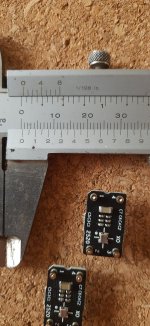
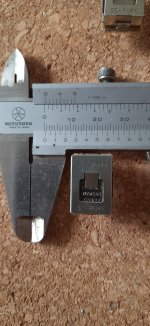
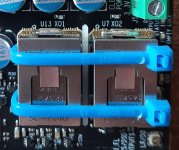
Thank you for your answer. I wouldn't add another board to the stack.1. RTOM Moongel (transparent) - one half between the socket and clocks and two on top of the clocks
2. Put Teradak filtering board on top: https://www.aliexpress.com/item/1005005006318539.html
also a small GPIO spacer needed, I use this one: https://www.audiophonics.fr/en/254m...le-pin-header-2x20-pins-3mm-unit-p-11802.html
3. Enjoy better sound from both resonance dampening & additional filtering, the Teradak board has a noticeable benefit on its own
https://www.diyaudio.com/community/...eapon-to-fight-the-jitter.192465/post-7479102
I wonder about that RTOM Moongel if is ok with the temperature of the clocks... I don't want it melt on the clocks or maybe became sticky so that could damage the clocks?
I think I need something on top of the clocks to keep them pressed downmaybe use Blu Tack for the Clock's.
- Home
- Source & Line
- Digital Line Level
- Asynchronous I2S FIFO project, an ultimate weapon to fight the jitter
